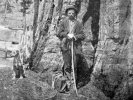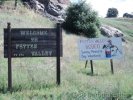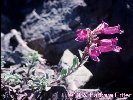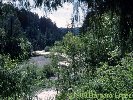 Carl Purpus, Plant Collector in
Western America
Carl Purpus, Plant Collector in
Western America Barbara Ertter
 Carl Purpus, Plant Collector in
Western America Carl Purpus, Plant Collector in
Western America | On the Trail, with Purpus, in California |
| Barbara Ertter |
 




Topics in this Article: Literature Cited | |
| Literature Cited: Other Articles: Purpus in Mexico: 0010
One of the most significant but least known of the early collectors in the California and the western United States was Carl Albert Purpus. In the 1890's he was the first botanist to explore many parts of
California, particularly the North Coast Ranges and southern Sierra Nevada, as well as Nevada, Utah, Arizona, and Baja California. Afterwards he moved to Mexico, where he lived the rest of his life.
Although his Mexican years and itinerary have been studied and published on (Sousa, M. 1969. Las colecciones botanicas de C. A. Purpus en Mexico. Univ. Calif. Publ. Bot. 5l: 1-36), his United States travels have been relatively unknown. Most of the following information is derived from translations of a series of articles describing his journeys from 1895-1899, published in "Mitteilungen der Deutschen Dendrologischen Gesellschaft" [Reports of the German Dendrological Society], supplemented with his letters to the Brandegees in the University of California at Berkeley herbarium archives, where he was an official (though unpaid) collector for the University Herbarium.
|
| Carl Albert Purpus
was born in either 1851 or 1853 near
Kirchheimbolanden, Germany, where his father was the royal forester.
His early years were spent roaming the forests and mountains of Germany.
He explored the whole of Switzerland and northern Italy, seeking out
rare alpine plants and developing his mountaineering abilities in the
process. He obtained a degree in Pharmacy in Giessen in 1876-77,
probably as a potential career that would allow some use of
his knowledge of the flora. Instead, however, he was recruited for
two years to collect winter-hardy plants in North America for the
arboretum at Zoeschen.
|
| The first year, in
the late 1870's, he travelled with his older brother,
Joseph Anton Purpus, who was head gardener in the Darmstadt Botanical
Garden. They collected plants in Canada, especially in the mountains of
British Columbia. The second year he travelled throughout the
northwestern United States: Oregon, Washington, Idaho, and Montana.
During the next few years he collected "free-lance" in the central
United States, especially in northern Illinois and Michigan. Species
that he sent to Germany that were either new to cultivation or rarely
grown included Kalmia microphylla, Phyllodoce glanduliflora,
and Spiraea menziesii. His income depended on sales of seeds,
cacti, pinecones, and anything else the German market would pay for.
Sets of his herbarium collections were also available for sale,
resulting in the wide distribution of his specimens. The first set
of specimens and types of new species was sent to the herbarium at
Berlin, which was tragically largely destroyed during World War II.
|
|  Carl A. Purpus, with a Sequoia and a dog.
Carl A. Purpus, with a Sequoia and a dog.
Locations: Grand Mesa. Uncompahgre Plateau. The real money lay not in
perennials, shrubs, and trees, but in cacti.
It was probably the lure of winter-hardy cacti that drew Purpus back
to the western United States, to the Grand Mesa and Uncompahgre Plateau
of western Colorado in 1892-93. The cacti he collected here were sent
to Dr. K. Schumann, a renowned cactus expert in Berlin, who named one
of the new species he found Mammillaria purpusii.
By current standards Purpus would be condemned by us for the
quantities of cacti he stripped from the landscape, as a letter in 1899
indicates:
|
| Locations: Basin. Letters: 10/1/1899 | I am going to have a big order for Anhalonium Lewisii (tons I expect) for E. Merck and Comp. They are making a virulent poison out of them as You know ... Please say nothing about those Anhalonium because Mercks keep it a secret.
|  South entrance to Potter Valley, California, May 1988.
South entrance to Potter Valley, California, May 1988.
Several of the shrubs
he shipped to Germany from the western United
States were also new to science, such as
Glossopetalon meionandrum Koehne. Others were more mundane,
such as sagebrush and greasewood. Some of the plants sent to Darmstadt
Botanical Garden have survived the years and the wars; a boojum from
Baja California collected in 1901 bloomed for the first time in 1960
[pers. comm., W. Richter, 1986].
|
| Literature Cited: To supplement income
from his collections, Purpus published several descriptions of the places he visited in the periodical Ausland. One of the first of these, on Mount Hood, appeared in the November 1890 issue (Purpus, C. A., 1890). Subsequent articles covered Spence's Bridge in British Columbia (Purpus, C. A., 1891b), the Bad Lands of the Dakotas (Purpus, C. A., 1892d), and the upper Yakima River of Washington (Purpus, C. A., 1893a). He ventured into general natural history with articles on rattlesnakes and pikas in the 1896-97 volume of Natur & Haus (Purpus, C. A., 1896c, 1896-97b).
|
|  Penstemon purpusii at Snow Mountain.
Penstemon purpusii at Snow Mountain.
Locations: Eel River. Potter Valley. Snow Mountain.
In 1894 Purpus shifted his base of operations further west,
to the mountains of California.
He had a cousin, Nettie Purpus, living in Potter Valley in
Mendocino Co., California, and spent the springs of several
years collecting in the area.
Most of his collections are from the foothills of Potter Valley,
but he also collected along adjacent stretches of the Russian River.
He followed the Eel River to collect on several of the higher
mountains in the area, including Hull Mountain and Mount San Hedrin,
and made some of the first collections on Snow Mountain,
where he discovered Penstemon purpusii.
|
|  Snow Mountain, from Old Eel River Drive, May 1988.
Snow Mountain, from Old Eel River Drive, May 1988.
In a letter to
Setchell, director of the UC herbarium, on 4 November 1926,
after the death of Townsend Brandegee, Purpus described how he first
became acquainted with the Brandegee's. As he recalled:
|
|
 Eel River, California.
Eel River, California. Locations: Mount San Hedrin.
| I was staying on the Summer resort of Mr. Liesly? at the foot of Mt. San Hedrin in the Coast range of Mendocino Co. I made the acquaintance of Mr. Charles Keeler the well known Ornithologist. Mr. Keeler gave me the advice to send my botan. specimens to be determined to Mrs. K. Brandegee in San Diego, so I did and all my plants collected in the Coast range, in the Sierra Nevada, in the Rocky Mts. of Colorado, Utah La Sal Mts, Arizona, Nevada etc. were sent to Mr. Brandegee to be named. I had just returned from a botanic trip in the Sequoya Park when I found a letter of Mrs. Brandegee - I was than living near Porterville - in which Mrs. Brandegee wrote me to come to San Diego to stay with Mr. and Mrs. Brandegee and collect there especially Cacti and in Lower California.
| This was the
beginning of a long and rewarding friendship and working
relationship. The Purpus-Brandegee connection began with a tentative
letter of introduction, followed by some of his collections. Purpus
was impressed with the promptness of the reply, as indicated in the
following excerpts from a letter to Katharine written 4 December 1895
(archives of the UC herbarium):
|
| Letters: 12/4/1896
| I am perfectly delighted for sending me allready the names of so many plants, and I hardly know how to express my thanks for Your great kindness. I was very glad to learn, that my collection is such an interesting one. I could not say much about it, because the place is new to me and because I have no flora. I will not sell plants to You, but will be perfectly happy to make a collection for You of all plants You mai desire on my tour next summer...
| Letters: 12/4/1896
| My name is Purpus. Pourpus in french, as my family is an old Huguenot family of Rochefort in France, driven out of the Country for their religion.
| From that point he
insisted on sending to the Brandegee's a set of
whatever plants they wanted, without charge, although he was supporting
himself largely through the sale of his collections. His letters during
his California years were always addressed to Katharine, and in several
published articles he cited Katharine as author of several new species,
but it was Townsend who identified and described Purpus's discoveries,
including the genus Purpusia in the Rosaceae. Katharine was
apparently a partner in part of his cactus-selling business, borrowing
money from Townsend when payment from Europe was delayed.
|
| Locations: Daunt. Springville.
Although Purpus went to Potter Valley almost every spring in the 1890's,
he had a winter residence and base of operations in Daunt, on the
outskirts of Springville, Tulare County. From here he had ready access
to the southern Sierra Nevada, where he collected in the summers of
1895-1897.
|
| Literature Cited: Other Articles: Purpus' Introductions: Unable to find an article page. Locations: Mount Whitney.
His first summer in the Sierra Nevada, 1895, was spent in the area around Mt. Whitney. His article describing the area to his German audience is full of the superlatives that characterize Purpus' writing (Purpus, C. A., 1986d).
|
| Other Articles: Purpus' Introductions: 0130 Locations: Owens Valley. Letters: 10/27/1896
| "One feels overwhelmed, as if placed in another world, when viewing these gray-white giants... All these toothlike peaks drop precipitously to the east in every sense of the word, the easternmost more than 3400 meters straight down into the Owens River Valley. The view from this precipice is truly terrifying."
| Other Articles: Purpus' Introductions: 0160
| "The sight of the giant trees of Sequoia gigantea is truly awesome. One feels completely overwhelmed, in another world, when seeing these monuments to ages long past for the first time."
|  Abronia alpina.
Abronia alpina. Other Articles: Purpus' Introductions: 0280 | "In granitic gravel below the volcano [of Mt. Whitney], I encountered a low mat-forming Allionia unknown to me, which was completely covered with rose-red flowers, providing a lovely sight beyond all description."
| This last was in
reference to a new species he collected on this trip,
Abronia alpina Brandeg. In the same article, the first of his
travelogues, he ended with a note on the hazards associated with the
beauty:
| |
[Next Page] | |
| [Published Biographies] [Travelogues and Articles] [Letters] [Plant Lists and Bibliography] [Site Administration] | | Date and time this article was prepared: 6/7/2002 7:32:37 PM |